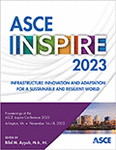Evaluating the GHG Emissions of Manufactured Housing through a Comprehensive Life-Cycle Assessment
Publication: ASCE Inspire 2023
ABSTRACT
With the country facing a shortage of affordable homes, manufactured housing is an option offering significant cost savings over traditional homes. In addition, manufactured housing has the potential to lower the environmental impacts, in particular, the embodied carbon of residential buildings. Consequently, investigating the environmental performance of manufactured housing is significant and important. This study aims to evaluate the environmental impacts of a manufactured house as a case study and recommend strategies and methods to reduce the environmental impacts. This study utilizes the life-cycle assessment (LCA) method with a cradle-to-site scope of analysis to evaluate the environmental impacts of a manufactured house. The LCA model includes material production processes (A1/A2/A3) and construction process (A4/A5) according to EN 15978 and ISO 14040 LCA frameworks. The results find that the initial emissions related to the building materials have a significant impact on total emissions, and using low-carbon and materials with a low transportation burden to reduce the carbon emissions of manufactured housing is recommended.
Get full access to this article
View all available purchase options and get full access to this chapter.
REFERENCES
ANSI/ISO (American National Standards Institute/ISO). (1997). Environmental management—Life cycle assessment—Principals and framework. Geneva, Switzerland.
Bilec, M., Ries, R., Matthews, H. S., and Sharrard, A. L. (2006). Example of a hybrid life-cycle assessment of construction processes. Journal of infrastructure systems, 12(4), 207–215.
Bilec, M. M., Ries, R. J., and Matthews, H. S. (2010). Life-cycle assessment modeling of construction processes for buildings. Journal of infrastructure systems, 16(3), 199–205.
Calder, A., Collins, M., and Duda, M. (2002). “Manufactured housing as a community and asset-building strategy.” In Report to the Ford Foundation by Neighborhood Reinvestment Corporation In collaboration with the Joint Center for Housing Studies of Harvard University (Vol. 2). Accessed January 11, 2023. https://search.credoreference.com/content/entry/sagehouse/manufactured_housing/0.
Ecoinvent. (2023). About ecoinvent. Retrieved from https://ecoinvent.org/the-ecoinvent-association/.
IEA (International Energy Agency). (2022). Global CO2 emissions from the operation of buildings rebounded in 2021 to above 2019 levels. Retrieved from https://www.iea.org/reports/buildings.
ISO. (2006). International standard: Environmental Management - Life Cycle Assessment - Requirements and Guidelines. 14040, Geneva, Switzerland.
ISO. (2006). International standard: Environmental Management - Life Cycle Assessment - Requirements and Guidelines. 14042, Geneva, Switzerland.
ISO. (2006). International standard: Environmental Management - Life Cycle Assessment - Requirements and Guidelines. 14044, Geneva, Switzerland.
Fenner, A. E., Kibert, C. J., Li, J., Razkenari, M. A., Hakim, H., Lu, X., Kouhirostami, M., and Sam, M. (2020). Embodied, operation, and commuting emissions: A case study comparing the carbon hotspots of an educational building. Journal of Cleaner Production, 268, 122081.
Fenner, A. E., Kibert, C. J., Woo, J., Morque, S., Razkenari, M., Hakim, H., and Lu, X. (2018). The carbon footprint of buildings: A review of methodologies and applications. Renewable and Sustainable Energy Reviews, 94, 1142–1152.
Hu, X., Chong, H. Y., and Wang, X. (2019). Sustainability perceptions of off-site manufacturing stakeholders in Australia. Journal of Cleaner Production, 227, 346–354.
IPCC. (2022). Climate Change 2022: Impacts, Adaptation and Vulnerability. Retrieved from https://www.ipcc.ch/report/ar6/wg2/.
Jin, R., Hong, J., and Zuo, J. (2020). Environmental performance of off-site constructed facilities: a critical review. Energy and buildings, 207, 109567.
Ji, Y., Li, K., Liu, G., Shrestha, A., and Jing, J. (2018). Comparing greenhouse gas emissions of precast in-situ and conventional construction methods. Journal of Cleaner Production, 173, 124–134.
Kibert, C. J., Chini, A. R., Rumpf-Monadizadeh, S., and Razkenari, M. A. (2017). Basics of Manufactured Construction. University of Florida.
Kamali, M., Hewage, K., and Sadiq, R. (2019). Conventional versus modular construction methods: A comparative cradle-to-gate LCA for residential buildings. Energy and Buildings, 204, 109479.
Kouhirostami, M., and Chini, A. R. (2022). Carbon emissions comparison in modular and site-built residential construction. Modular and Offsite Construction (MOC) Summit Proceedings, 233–240.
Kouhirostami, M., Chini, A. R., and Sam, M. (2023). Investigation of Current Industry Strategies to Reduce the Cost of Financing a Manufactured Home. Journal of Architectural Engineering, 29(3), 03123002.
Matthews, H., Hendrickson, C. T., and Matthews, D. H. (2014). Life Cycle Assessment Quantitative Approaches for Decision That Matters.
MHI (Manufactured Housing Institute). (2021a). “2022 manufactured housing facts-industry review.” Retrieved from https://www.manufacturedhousing.org/wp-content/uploads/2022/04/2022-MHI-Quick-Facts-updated-05-2022-2.pdf.
Miller, T. R., Gregory, J., and Kirchain, R. (2016). Critical issues when comparing whole building & building product environmental performance.
Quale, J., Eckelman, M. J., Williams, K. W., Sloditskie, G., and Zimmerman, J. B. (2012). Construction matters: Comparing environmental impacts of building modular and conventional homes in the United States. Journal of industrial ecology, 16(2), 243–253.
United Nations Environment Programme. (2022). CO2 emissions from buildings and construction hit a new high, leaving sector off track to decarbonize by 2050: UN. Retrieved from https://www.unep.org/news-and-stories/press-release/co2-emissions-buildings-and-construction-hit-new-high-leaving-sector.
Sharrard, A. L., Matthews, H. S., and Ries, R. J. (2008). Estimating construction project environmental effects using an input-output-based hybrid life-cycle assessment model. Journal of Infrastructure Systems, 14(4), 327–336.
Suh, S., and Huppes, G. (2005). Methods for life cycle inventory of a product. Journal of cleaner production, 13(7), 687–697.
Information & Authors
Information
Published In
History
Published online: Nov 14, 2023
ASCE Technical Topics:
- Air pollution
- Buildings
- Business management
- Case studies
- Construction materials
- Emissions
- Engineering fundamentals
- Engineering materials (by type)
- Environmental engineering
- Housing
- Infrastructure
- Life cycles
- Materials engineering
- Materials processing
- Methodology (by type)
- Pollution
- Practice and Profession
- Research methods (by type)
- Residential buildings
- Structural engineering
- Structures (by type)
- Urban and regional development
Authors
Metrics & Citations
Metrics
Citations
Download citation
If you have the appropriate software installed, you can download article citation data to the citation manager of your choice. Simply select your manager software from the list below and click Download.
